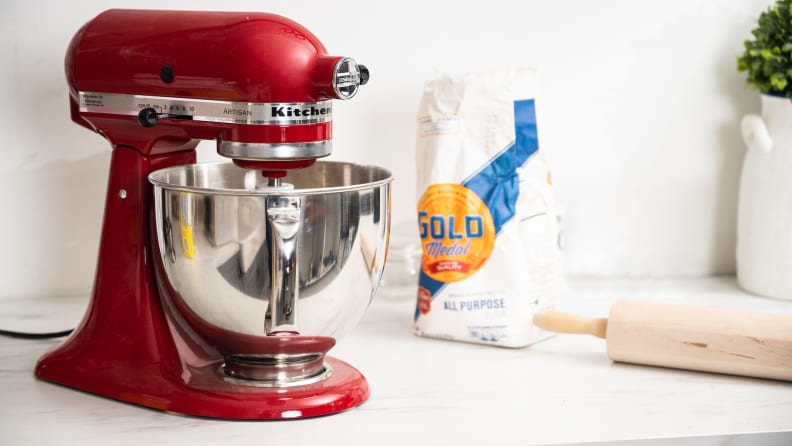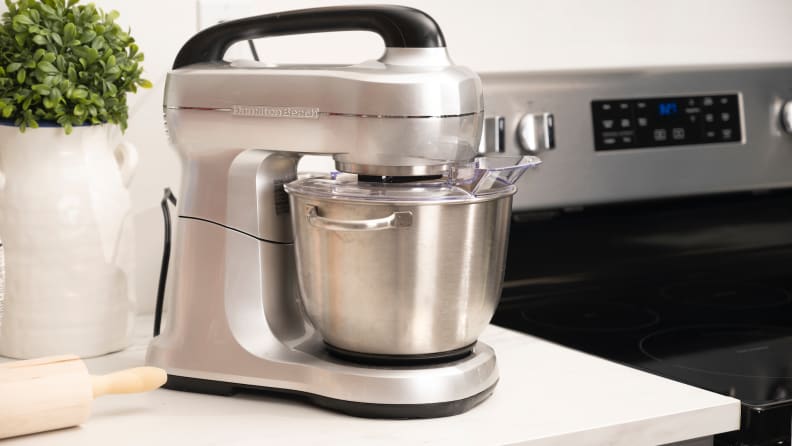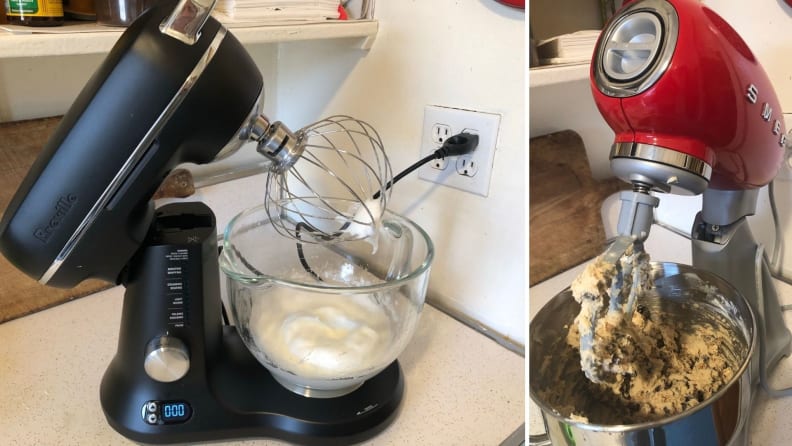Kitchenaid Mixer Speed Lever Springs Back to an on Position

Credit: Reviewed / Betsey Goldwasser

After many rounds of testing, the KitchenAid Artisan 5-Quart Stand Mixer remains the best stand mixer you can buy.

Credit: Reviewed / Betsey Goldwasser

For its price and performance, the Hamilton Beach Seven-Speed mixer makes a great alternative to the KitchenAid Artisan.
How We Tested Stand Mixers
The Testers
Hi, I'm Sharon Franke, and I've been reviewing kitchen equipment for more than three decades. Before that, I cooked and baked professionally in New York City restaurants for seven years.
My passion for home baking jump-started my career. As a teenager, I stirred up boxed cake mixes with a wooden spoon. When I rented my first apartment, I graduated to a stand mixer and became an expert at baking everything from chocolate-chip cookies to flourless cakes to sourdough bread.
This guide was first put together by former Reviewed cooking editor Cassidy Olsen and Erin Fife, a Reviewed contributor.
The Tests

Credit: Reviewed / Sharon Franke
We whipped up egg whites and mixed chocolate chip cookie dough in each stand mixer, like these from Breville and Smeg, as part of our testing process.
To find the best stand mixers, we put top stand mixers through their paces. With the whisk attachment, we whipped egg whites, timing how long each mixer took to create stiff peaks and measuring the volume created.
Then with the flat beater, we used each model to mix a French vanilla cake mix to see if it could beat the ingredients thoroughly in the time suggested on the instructions on the box. Next, with the beater, we tested each model's ability to cream butter and sugar, then incorporate eggs, flour and other ingredients to mix a thick batter loaded with chocolate chips, granola, and raisins.
With the dough hook, we kneaded dough for one or two loaves (according to the manufacturer's recommendation) of white bread, noting how well each one handled the heavy load.
As we worked, we gauged how easy it was to use each mixer, including access the bowl, install and remove the attachments and operate the controls and how much noise it made. We assessed the helpfulness of the manuals, how easy the mixers were to clean, and whether or not they had helpful special features. Because this is an appliance that will live on your countertop, we took its appearance into consideration.
How to Choose a Mixer
Do you need a stand or hand mixer? The first thing to decide is whether to spring for a stand mixer or if you can get away with a hand mixer. If you bake often, it's worth making the investment and dedicating countertop space to a stand mixer.
While all of our best hand mixers can get just about any mixing job done, they begin to feel heavy in your hand after a minute or two, even when you're whipping up an angel food cake but especially when you're beating a sturdy cookie batter or yeast dough.
Don't be wowed by watts or bowl size. Neither wattage or bowl capacity is a good indicator of how a mixer will perform unless all other factors are identical. It's the overall design of the mixer that determines a mixer's efficiency and what kind of results you'll get.
Instead of looking at the watts or the bowl size, check to see how much flour or how many cookies and/or loaves of bread the mixer can handle at once. You may have to dig a little, but most manufacturers' websites contain this information. If your favorite bread recipe yields two loaves, make sure any mixer you consider will be able to do the job.
Should you get a bowl-lift or tilt-head stand mixer? On tilt-head stand mixers, you push a button or a lever to tilt the head up to insert or remove the mixing bowl and attachment and easily add ingredients and scrape the bowl during mixing. These mixers can be pushed back under a cabinet when not being used.
With bowl-lift mixers, you turn a crank to raise the bowl for mixing and lower it to remove the bowl and beaters, add ingredients or scrape the bowl. It's not quite as convenient to perform these tasks on a bowl-lift model. But in general, these mixers are more powerful and come with bigger bowls.
If cakes, muffins, and mousses, take top place in your repertoire, opt for an easy to use tilt-head model. On the other hand, if you're a semi-pro who is always giving baked goods away and wouldn't think of serving anything but your own made-from-scratch bread, you'll want the power and size that a bowl-lift model offers.
Other Stand Mixers We Tested
More Articles You Might Enjoy
- The Best Hand Mixers
- The Best Mixing Bowls
- The Best Loaf Pans
- The Best Spatulas
Checking our work.
Our team is here for one purpose: to help you buy the best stuff and love what you own. Our writers, editors, and lab technicians obsess over the products we cover to make sure you're confident and satisfied. Have a different opinion about something we recommend? Email us and we'll compare notes.
Shoot us an email
Kitchenaid Mixer Speed Lever Springs Back to an on Position
Source: https://www.reviewed.com/home-outdoors/best-right-now/best-stand-mixers
0 Response to "Kitchenaid Mixer Speed Lever Springs Back to an on Position"
Post a Comment